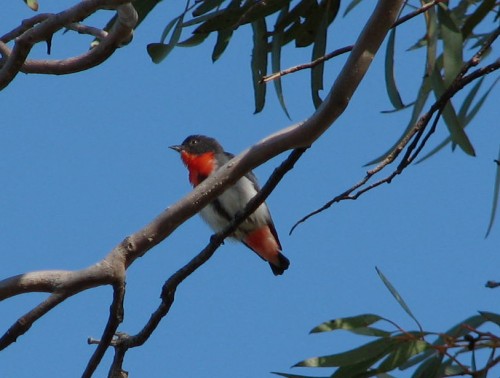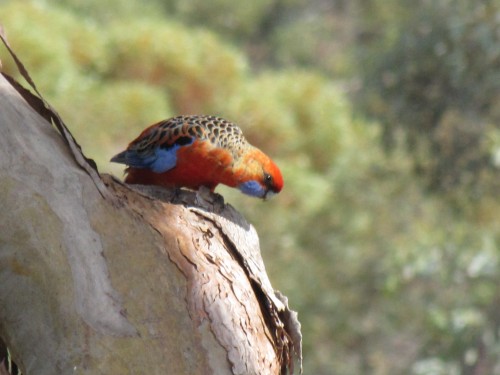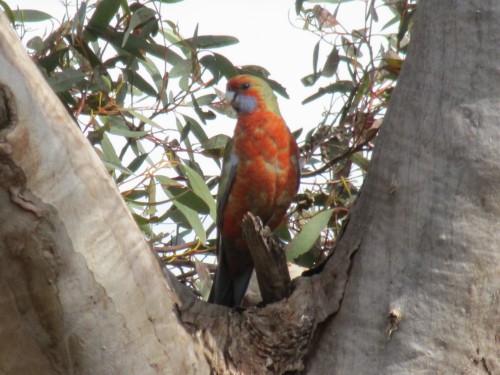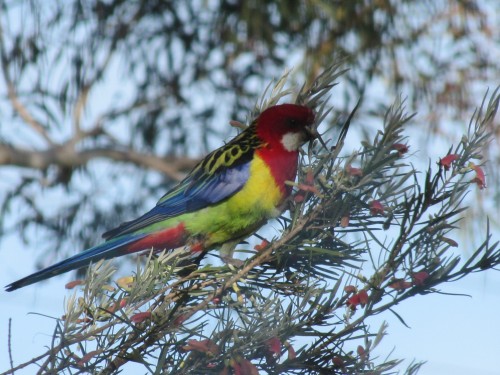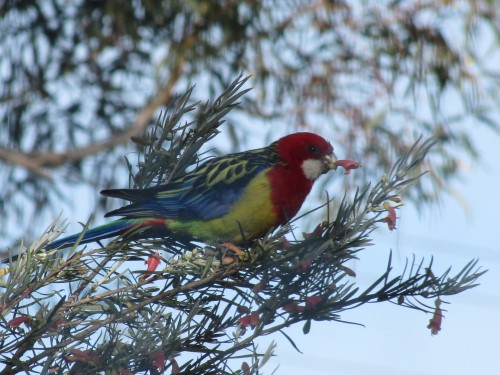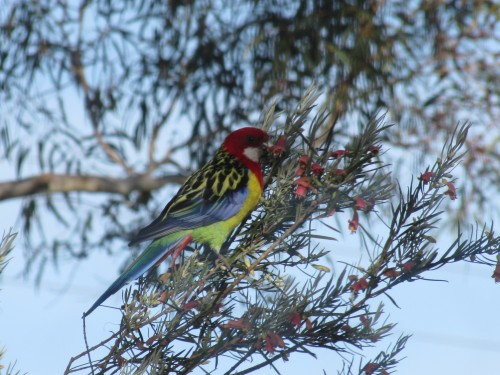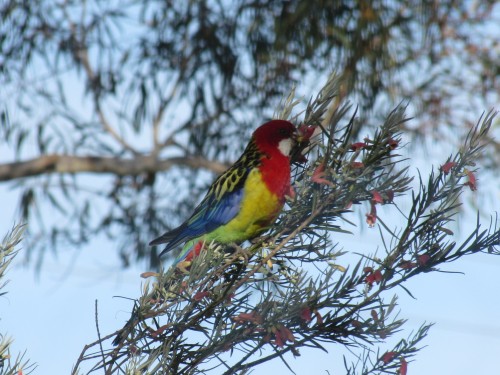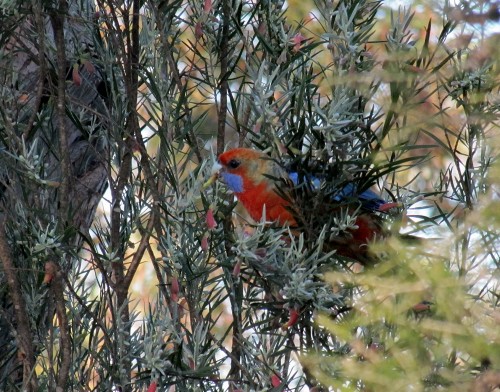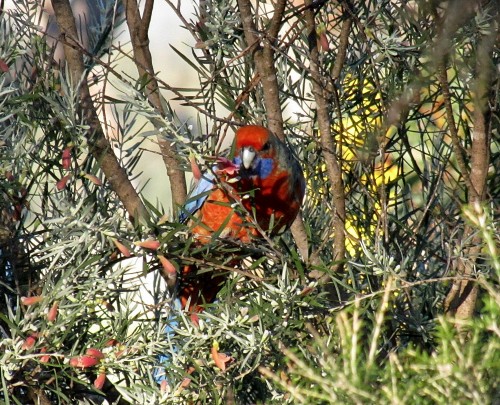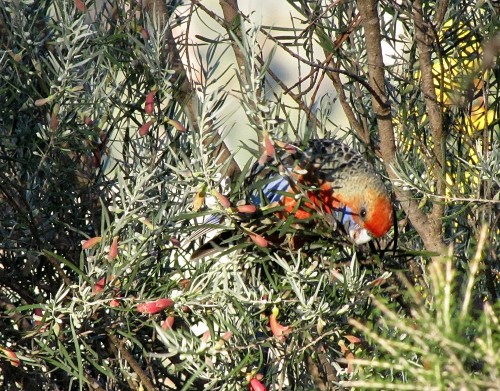A Mistletoebird pays a quick visit
Yesterday my wife and I were taking a short break from the jobs we had been doing. Sitting on our back veranda we were enjoying the lovely sunny spring weather we have had this week. It was afternoon tea time and we were enjoying a well deserved cup of tea. The back veranda has been a bit of a mess over the winter months and the weather has been too cold to spend too much time cleaning it up. Now that the spring weather is here we had a renewed enthusiasm for being outside.
While we sat there we enjoyed the constant parade of birds hopping around in the garden nearby. Many others were calling and we enjoy trying to identify them by call alone, a good way of honing one’s identification skills. Our resident Superb Fairy-wrens entertain us every day, as do the Mallee Ringneck parrots, the Eastern Rosellas and the Galahs. We can’t work out if the Galahs are actually nesting or not. The Spotted Turtledoves often join in the chorus and in recent days we have had the delight of Peaceful Doves also hanging around near the house.
As we sat there we were delighted to have a female Mistletoebird fly in and alight on a bush in full view just three metres from us. We were able to see the soft, dull grey colours of the feathers on her back, a stark contrast with the blue-black feathers of the male (see photo above). I didn’t have the camera handy, and the bird flew off after less than a minute, so I have shared a photo of the male taken some years ago. I do have one photo of the female, but unfortunately it is not in focus. Sigh.
I cannot categorically say that this is a resident species in our garden and on our 5 acre property, but it is certainly a regular visitor. I hear its call almost every week. Many years ago this was the first species to nest in one of the trees we planted after moving here. There may have been other species before it, but this was the first one we positively recorded doing this. The nest is a delicate pear-shaped container with a small entrance near the top. It is made primarily from spiders’ webs, small leaves, lichen and other soft materials, and hangs from small twigs or leaves. They are just coming into their breeding season, so I need to keep an eye open for a nest. This species is found throughout mainland Australia except in the driest regions. It is not present in Tasmania.
Further reading:
- Beautiful Mistletoebird
- Great Birding Moments #3
- If you click on the name of any of the bird species mentioned in the text above, you can go to other articles about that species.
Rosellas come to visit
This morning while we were having breakfast a small flock of four Adelaide Rosellas came to visit our garden. It was delightful to see them feeding on some of the flowers of our native plants such as eremophilas. This sighting is notable in so much as they are uncommon visitors to our garden here on the outskirts of Murray Bridge, some 80km south east of Adelaide, South Australia.
Adelaide Rosellas are a sub-species of the widespread Crimson Rosella, a common species in southern and eastern Australia. The Adelaide Rosella is largely confined to the Adelaide region through to the mid-north districts of the state. Until recent years I have not observed this sub-species so far east of the Mt Lofty Ranges, and they seem to be extending their range eastwards. We are now seeing them every few months in our garden.
Further reading:
A small birding accident
This morning I had a small birding accident. I didn’t hurt myself – or anyone or anything else. This week the forecast is for severe hot weather after a prolonged period of mild weather, so I decided before breakfast that our bird baths should be replenished every morning. The resident birds sure appreciate the fresh water every day.
I filled a handy bucket from the rainwater tap – I prefer to treat them to rainwater rather than tap water – and trundled outside into the garden. As I carried the very full bucket of water I stepped off the veranda and… disaster! The cheap plastic bucket shattered into about a dozen pieces and water splashed all over my shoes, socks, and legs. The bucket – what was left of it – was immediately thrown in the rubbish bin and another one fetched and filled from the tap over the laundry tub. This time the water reached its destination without further incident.
My efforts were rewarded about an hour later. While reading the paper at the table in our sun room two birds flew in to have a drink and a bath. One was a Mallee Ringneck and the other an Eastern Rosella (see photo above) Strangely, these two birds have been seen together in our garden on many occasions over the last few years. Eastern rosellas are not common in this area.
Further reading:
Now the Eastern Rosella is back home
For almost two years now we have had an Eastern Rosella occasionally visit our garden and patch of mallee scrub. During some weeks we see it several times a day, every day. On other occasions it may only visit once and then not again for a week or two. It is an unusual visitor for a number of reasons.
- Eastern Rosellas are not normally found in the Murray Bridge region. They are common in the eastern states and even in the south east of South Australia. They have been introduced to the Adelaide region. All I can assume is that this species is extending its range or this one bird has escaped from someone’s aviary – or has been released.
- The other unusual matter relates to its behaviour: it is regularly seen in the company of a Mallee Ringneck. We have up to a dozen ringnecks around at any one time, but most of them do not tolerate this “interloper” and will vigorously chase it off. It keeps returning; such persistence.
For the last month we hadn’t seen the rosella, but earlier this week it reappeared, again in the company of a ringneck and again being harassed by the other ringnecks. On Wednesday it posed nicely for my camera while eating the flowers of one of our Eremophila youngii bushes.
Further reading:
- Now we have two Eastern Rosellas
- Adelaide Rosellas in our garden
- Mallee Ringneck Parrot
- Parrots eating our flowers
- Eremophilas – articles about Eremophilas on my wife’s site.
Adelaide Rosellas in our garden
In our garden and five acre block of land on the outskirts of Murray Bridge in South Australia we have many different species of birds – over 100 in fact. Of those that are resident or occasional visitors we have a good range of parrots.
Perhaps the most abundant would be the Galah, a very common species in the district with flocks numbering in the many hundreds. Another common species is the Little Corella but this is usually a species which only flies overhead, also in large numbers. Other parrots present in smaller numbers include Rainbow Lorikeets, Purple-crowned Lorikeets and Sulphur-crested Cockatoos. Mallee Ringnecks are a resident breeding species. One individual keeps company with an Eastern Rosella, a species not normally present around here (I suspect it is a cage escape.)
Every month or so we have a short visit from several Adelaide Rosellas, shown in today’s photos. This is a sub-species of the Crimson Rosella of the eastern states. The Crimson Rosella is a much deeper red colour, while the Adelaide Rosella is more of an orange colour. In the northern parts of its range in South Australia (eg the lower Flinders Ranges) the orange colour can be quite washed out.
The birds which came to visit us last week are much brighter red than most Adelaide Rosellas, leading me to think that they may be moving north from the South East districts of South Australia where the more brightly coloured birds occur. Just a theory. On the other hand, I don’t have to travel too many kilometres west to see the typically washed out orange rosellas common in the Adelaide region.
